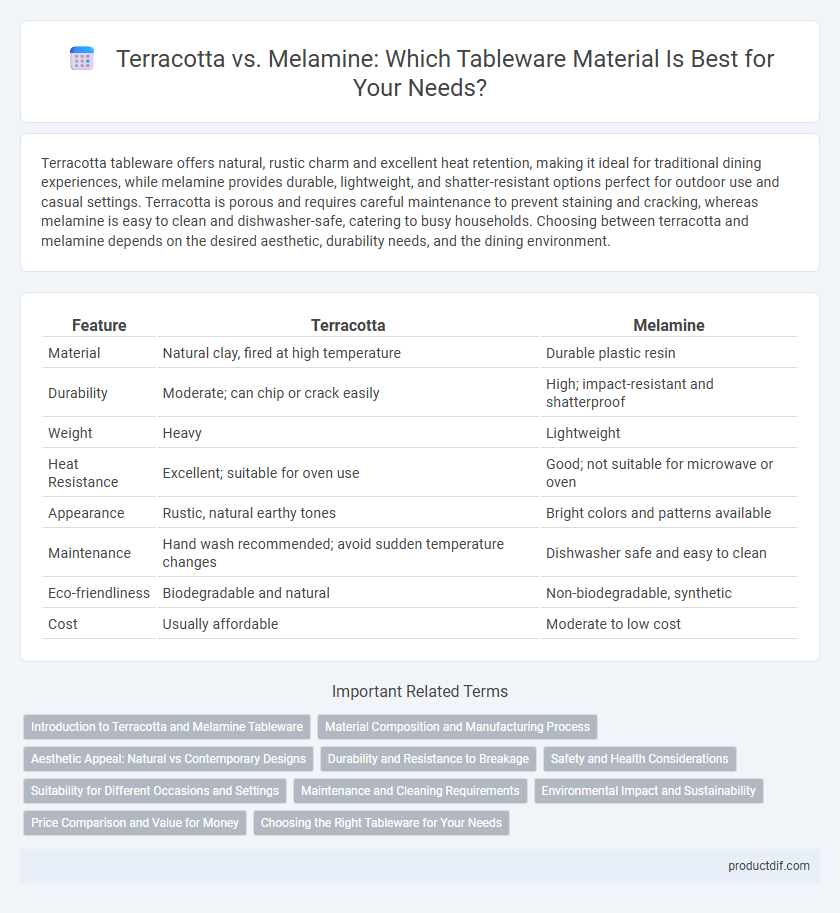Terracotta tableware offers natural, rustic charm and excellent heat retention, making it ideal for traditional dining experiences, while melamine provides durable, lightweight, and shatter-resistant options perfect for outdoor use and casual settings. Terracotta is porous and requires careful maintenance to prevent staining and cracking, whereas melamine is easy to clean and dishwasher-safe, catering to busy households. Choosing between terracotta and melamine depends on the desired aesthetic, durability needs, and the dining environment.
Table of Comparison
| Feature | Terracotta | Melamine |
|---|---|---|
| Material | Natural clay, fired at high temperature | Durable plastic resin |
| Durability | Moderate; can chip or crack easily | High; impact-resistant and shatterproof |
| Weight | Heavy | Lightweight |
| Heat Resistance | Excellent; suitable for oven use | Good; not suitable for microwave or oven |
| Appearance | Rustic, natural earthy tones | Bright colors and patterns available |
| Maintenance | Hand wash recommended; avoid sudden temperature changes | Dishwasher safe and easy to clean |
| Eco-friendliness | Biodegradable and natural | Non-biodegradable, synthetic |
| Cost | Usually affordable | Moderate to low cost |
Introduction to Terracotta and Melamine Tableware
Terracotta tableware, crafted from natural clay, offers an earthy aesthetic with excellent heat retention properties, making it ideal for rustic dining settings. Melamine tableware, composed of durable thermoset plastic, provides lightweight, shatter-resistant alternatives perfect for outdoor use and casual environments. Both materials serve distinct purposes, with terracotta highlighting traditional, handcrafted appeal and melamine emphasizing practicality and modern design.
Material Composition and Manufacturing Process
Terracotta tableware is made from natural clay that is shaped and fired at high temperatures, resulting in porous, earthy ceramics ideal for rustic dining settings. Melamine tableware is produced from a durable thermosetting plastic, created through a molding process involving melamine resin and formaldehyde, offering lightweight, impact-resistant, and heat-resistant properties. The manufacturing of terracotta involves traditional kiln-firing techniques, whereas melamine undergoes industrial molding and curing, enabling mass production with consistent quality and vibrant finishes.
Aesthetic Appeal: Natural vs Contemporary Designs
Terracotta tableware offers a warm, earthy aesthetic with its natural clay texture and handcrafted imperfections, creating a rustic and authentic appeal that complements traditional and farmhouse-style settings. Melamine tableware features sleek, glossy finishes and vibrant colors with modern patterns, providing a contemporary, durable option ideal for casual dining and outdoor use. Choosing between terracotta and melamine depends on whether a natural, artisanal look or a polished, versatile design best suits the dining environment.
Durability and Resistance to Breakage
Terracotta tableware offers excellent durability with natural heat retention but is prone to chipping and breaking under heavy impact due to its porous and brittle nature. Melamine tableware boasts superior resistance to breakage and shattering, making it ideal for high-traffic environments and outdoor use, thanks to its robust, non-porous resin composition. Melamine's impact resistance and lightweight durability outperform terracotta in scenarios requiring longevity and daily handling.
Safety and Health Considerations
Terracotta tableware is made from natural clay, making it free from harmful chemicals and safe for food use, but it may absorb liquids and is prone to chipping if not glazed properly. Melamine tableware is durable and lightweight but can release toxic formaldehyde when exposed to high temperatures or scratched, posing health risks. Choosing terracotta ensures a natural, chemical-free option while melamine requires careful use to avoid potential chemical leaching.
Suitability for Different Occasions and Settings
Terracotta tableware offers rustic charm and heat retention, making it ideal for casual dining, outdoor gatherings, and traditional meals where a natural aesthetic enhances the experience. Melamine tableware provides durability, lightweight convenience, and shatter-resistance, perfectly suited for picnics, children's parties, and high-traffic commercial settings like cafeterias and casual restaurants. Choosing between terracotta and melamine depends on the occasion's formality, desired ambiance, and practical needs such as ease of cleaning and breakage risk.
Maintenance and Cleaning Requirements
Terracotta tableware requires gentle hand washing with mild soap to prevent cracking and deterioration, as it is porous and can absorb stains and odors. Melamine is highly durable and dishwasher-safe, offering easy, low-maintenance cleaning that resists chipping and fading. Choosing between terracotta and melamine depends on balancing the rustic aesthetic of terracotta with the convenience and robustness of melamine maintenance.
Environmental Impact and Sustainability
Terracotta tableware is biodegradable and made from natural clay, making it an eco-friendly choice with a low carbon footprint and minimal chemical processing. Melamine, derived from plastic resin, is non-biodegradable and poses challenges in recycling, contributing to long-term environmental pollution. Choosing terracotta supports sustainability by reducing plastic waste and promoting natural material use over synthetic alternatives.
Price Comparison and Value for Money
Terracotta tableware often features a higher upfront cost due to its handcrafted nature and natural materials but offers exceptional durability and aesthetic appeal that can justify the investment over time. Melamine tableware is typically more affordable and lightweight, making it a popular choice for casual use and large gatherings, though it may wear faster and lacks the premium look of terracotta. When considering value for money, terracotta provides long-lasting quality and timeless design, whereas melamine excels in cost-effectiveness and practicality for everyday use.
Choosing the Right Tableware for Your Needs
Terracotta tableware offers natural heat retention and rustic aesthetics, making it ideal for serving hot dishes and enhancing presentation with an earthy charm. Melamine tableware provides lightweight durability and resistance to breakage, perfect for outdoor dining, children, or high-traffic environments requiring easy maintenance. Selecting between terracotta and melamine depends on factors like usage frequency, desired visual impact, and practicality for specific dining settings.
Terracotta vs Melamine Infographic

 productdif.com
productdif.com